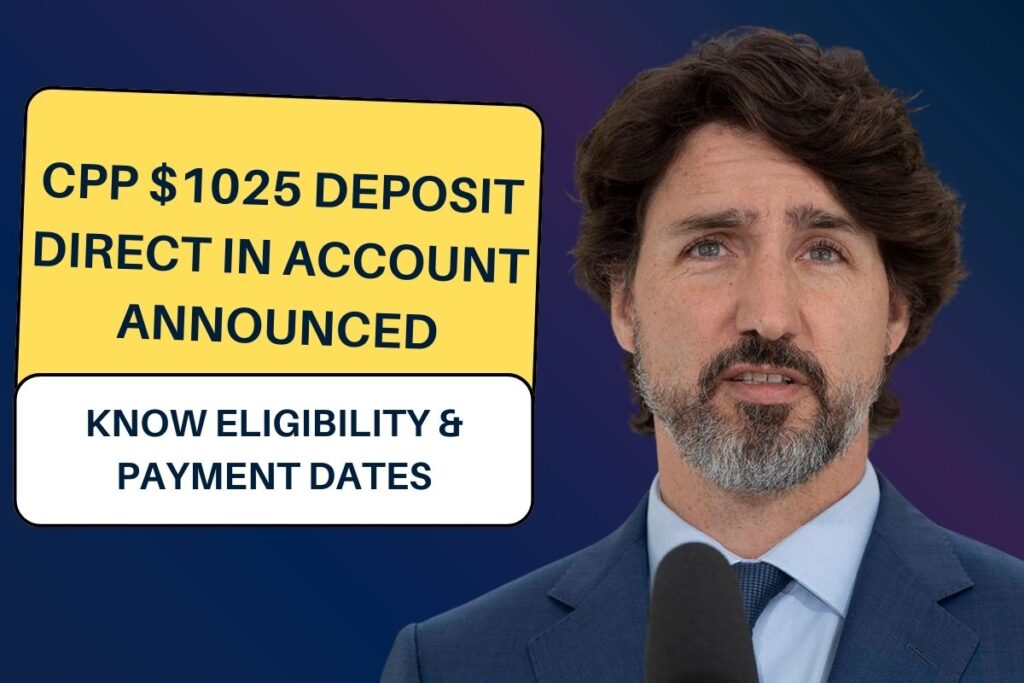As per YouTube videos, there is a news that CPP $1025 Deposit Direct In Account Announced but i dont know the authenticity of this news. I will talk more about $1025 CPP Payment 2024 in this post, so please read it. You can CPP $1025 Payment 2024 Apply Online or on paper using your My Service Canada account to start earning CPP retirement payments. Service Canada says that within 120 days, you should get a letter informing you of their decision. Applying ahead of time is therefore the best way to guarantee that you begin receiving your pension by the date of your choice and preference.
CPP $1025 Deposit Direct In Account Announced
After doing job for several years, retirement is a big life event that has to be carefully considered. The Canada Pension Plan is one of the most popular ways for Canadians to get retirement income. A taxed monthly payment, the CPP $1025 Payment 2024 is meant to supplement your income in retirement. An earnings-related public pension scheme is the Canada Pension scheme (CPP). Canadians and their families get a monthly payment from the CPP to help partially replace their income in the event of retirement, disability, or death. Regular CPP contributions are required for working Canadians to be $1025 CPP Payment 2024 Eligible.
$1025 CPP Payment 2024 Details
| Post Title | CPP $1025 Deposit Direct In Account Announced |
| Country | Canada |
| Department Name | Service Canada |
| Category | Financial Aid |
| Benefit Amount | $1025 |
| Official Website | Canada.ca |
When to start to get CPP retirement benefits?
Age 65 is the typical commencement age for CPP retirement benefits but you can start getting CPP at any age between 60 and 70, or even before or later. Your CPP retirement income will be lowered if you begin collecting it before the age of 65. The decrease will be 0.6% each month, or 7.2% annually, with a maximum loss of 36% at age 60. However, your benefits will grow by 0.7% each month (8.4% annually) if you delay claiming CPP until after the age of 65, with a maximum increase of 42% at age 70.
When you get 70 years old, your monthly maximum will be there. Delaying the pension till after the age of 70 usually has no benefits. Moreover, one need not cease employment in order to be eligible for a CPP retirement benefit. Regardless of job status, people can start collecting CPP at any time after the age of 60.

How much do I pay into CPP?
- At a rate of 5.95% of the EPE, both employers and workers contribute to the CPP. In 2024, $68,500 is the highest amount that may be pensioned. Keep in mind that the basic exemption amount, or the first $3,500 of income, is free from CPP contributions. In 2024, this corresponds to a maximum CPP contribution of $3,867.50. Self-employed individuals are required to contribute the employee and employer portions, this equals 11.9% of pensionable earnings. This means that the maximum contribution for self-employed people in 2024 will be $7,735.00.
- Above the MPE, starting in 2024, extra CPP contributions will be needed, with a second earnings cap of $73,200 (2024). Employer and employee contributions to the second tier are both 4%, with a $188 per person maximum contribution. Once more, the rate for self-employed contributions will rise to 8%, with a maximum contribution of $376 (2024). The fraction of an individual’s salary over $73,200 is exempt from CPP payments 2024.
How to boost CPP Payment
You could find, after using a Canada Pension calculator, that the retirement lifestyle you had earlier cannot be supported by the amount of money you would get. Although the maximum monthly CPP benefit payout for 2024 is $1,364.60, Canadians will only earn an average of $702.77 per month. In comparison to their working years, many Canadians must live on extremely little incomes in retirement, even with OAS and other pension funds.
Your pre-tax CPP benefits are set 12 months after you begin receiving your pension; however, you can boost your after-tax benefits by claiming tax deductions. The CPP pension income is taxed similarly to other types of income; the lower your tax rate, the less tax you have to pay.
How CPP Works
In 1965, as retirement poverty among Canadians grew, federal-provincial talks resulted in the creation of the CPP. At the time, it was intended to pay 25% of an employee’s average lifetime earnings, up to a certain maximum amount of earnings covered. Employers, employees, and self-employed people all made payroll payments to the CPP in order to fund it initially. Current contributions determined benefits. The CPP currently receives investment income in addition to payroll contributions, these are paid at the full rate by self-employed individuals and evenly divided between employers and workers.
| Our Homepage | PSTET2023.org |

